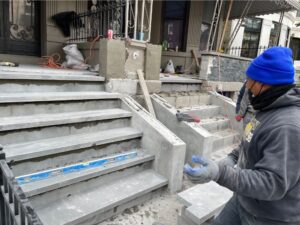 Concrete is the most popular choice for property owners constructing steps or stairs in the outdoor setting. The durability and aesthetic value of concrete make it a preferred masonry material. Nevertheless, over time, they succumb to diverse structural damage requiring step repair Queens by a professional contractor.
Concrete is the most popular choice for property owners constructing steps or stairs in the outdoor setting. The durability and aesthetic value of concrete make it a preferred masonry material. Nevertheless, over time, they succumb to diverse structural damage requiring step repair Queens by a professional contractor.
Cities undergoing constant temperature fluctuations and climatic changes like Bronx, Queens, Manhattan, Long Island, Brooklyn, and Richmond Hill, witness immense adverse impacts on concrete structures, including steps. Chipping, cracking, and spalling are common issues in concrete steps, posing considerable safety hazards. When you do not address such problems promptly, the damage becomes severe, often demanding step replacement.
Recognizing the cause of damage is essential to resolve it effectively with lasting results. Therefore, we will explore the factors leading to concrete step degradation to identify its ideal fix.
Concrete Step Damage: Common Factors
Knowing and understanding the cause of step damage will enable efficient remediation of the same. Without further delay, let us check it out:
- Weathering- External elements like heat, light, moisture, and dust cause general wear and tear. These are signs of ageing. You cannot refrain from it at any cost! Thus, the concrete becomes weak, and you need step repair Queens by an expert.
- Freeze-Thaw Cycles- Extreme temperatures lead to concrete expansion and contraction. When occurring persistently, it creates tension resulting in cracking and chipping.
- Chemical Reactions- Chemical exposure, like salts and cleaning agents, react with concrete minerals, affecting its structural integrity and leading to surface deterioration.
- Moisture Infiltration- Moisture in any form is a fundamental culprit in all masonry damage. Water seepage through cracks and crevices damages the construction base giving way to critical problems. Also, mold and mildew aggravate the situation that can be fixed only by step repair specialists.
- Foot Traffic- Abrasion and wear are prevalent with regular foot traffic. Physical impacts and heavy loads are also responsible for concrete step degradation.
- Settling Soil- Shifting and settling the underneath ground often cause cracks and improper inclination of the steps.
With the known causes behind concrete damage, it is time we focus on step repair Queens.
Ways to Resolve Concrete Step Damage
The extent of damage defines the type of damage remediation in concrete steps. Here are the popular techniques employed to resolve cracked, chipped, or broken concrete steps:
- Patching- Patching is done to seal small cracks that appear on the surfaces. The process is simple, unlike porch step replacement which is invasive and time-consuming. A concrete patching compound is poured over the cracks to fill the gaps. It restricts water penetration saving the concrete from further damage.
- Resurfacing- When you have an uneven surface with chipping and holes, it is best to recoat it with a thin layer of concrete mix. It will offer you a flawlessly even appearance and an improved curb appeal.
- Sealing- Larger and deeper cracks require intensive treatment. Premium-grade concrete sealer is applied to the cracks individually to seal the gaps thoroughly. These sealers provide additional protection against corrosion, staining, and surface damage. The step repair cost is higher when you opt for good quality waterproof sealers.
- Reinforcement- If the damage is due to settling or ground movement, steel bars or wire mesh are used to reinforce the structure. It promotes strength and stability in the concrete steps.
- Replacement- When the damage is beyond repair, porch step replacement is the only alternative. The existing structure is removed, and a new one is installed, ensuring greater longevity and enhanced aesthetics.
To conclude, you can extend the life of concrete steps with adequate maintenance, installing proper drainage, avoiding harsh chemicals, and addressing early signs of damage. However, never skip professional assistance whenever needed.
